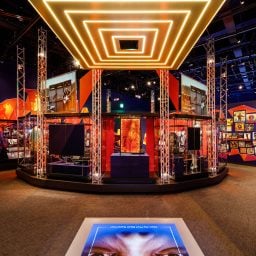The period room is a kind of historical fantasy. It’s an imagined construction, a grand sitting room that glorifies the spoils of European aristocrats. But beyond the display of portraits and property, the function of the period room is often to shore up a general sense of cultural superiority among those who have inherited the benefits of gentry and labor—through feudalism, slave-based economies, and stolen colonial wealth—or their cousin, ideological whiteness.
“Before Yesterday We Could Fly: An Afrofuturist Period Room,” now open at the Metropolitan Museum of Art in New York, is a different kind of period room and a conceptual intervention. The Met teamed up with Oscar-winning production designer Hannah Beachler, whose credits include Black Panther, and Michelle Commander, the associate director and curator at NYPL’s Schomburg Center for Research in Black Culture, to push the boundaries of the genre by taking inspiration from Afrofuturism.
Overall, the concept of Afrofuturism speculates on a future in which Black people are thriving beyond the wildest dreams of our ancestors. With resources in oral and literary traditions, the concrete specificity of imagination is expressed in the music of Sun Ra and the unblinking social criticism in the science fiction of Octavia Butler.
Imagination is at the core of the Met’s project, too. The room’s title, “Before Yesterday We Could Fly,” is inspired by children’s book author Virginia Hamilton’s 1985 retelling of the Flying African tale, a celebration of the imagination and creativity of enslaved peoples.
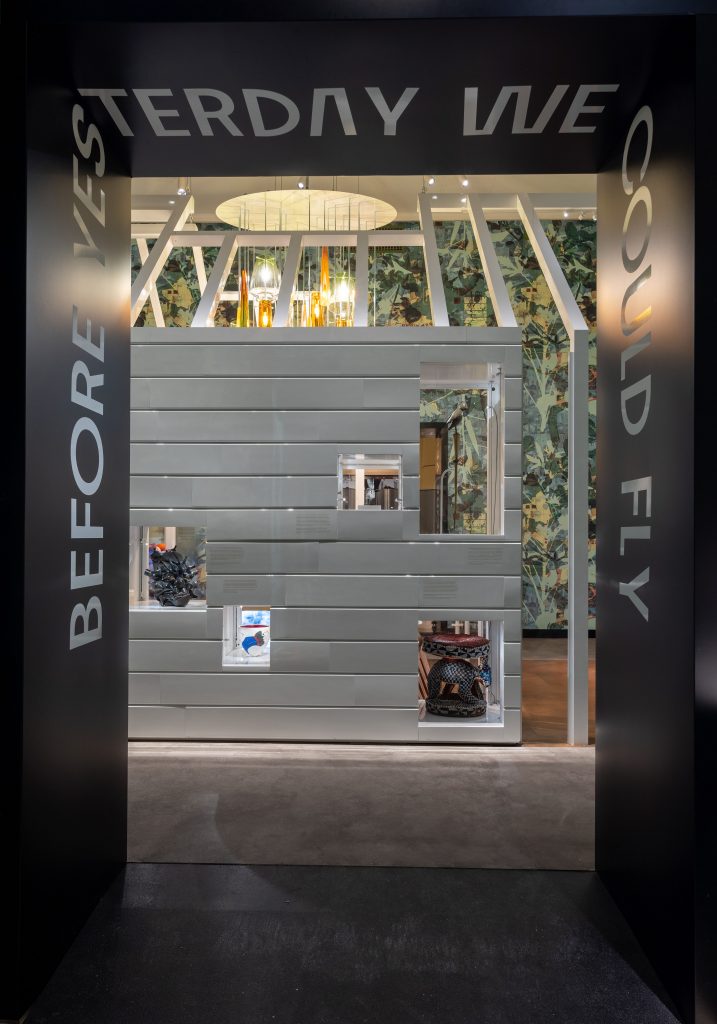
“Before Yesterday We Could Fly: An Afrofuturist Period Room.” Courtesy The Metropolitan Museum of Art/ Photo by Anna-Marie Kellen.
To root the exhibition in the reality of specific historical erasure, the curators created a space that embraces the memory of Seneca Village, a thriving 19th-century New York City community of predominantly Black property owners and tenants. It was situated not too far from the Met, on what is now the western perimeter of Central Park, or what remains the unseated lands of indigenous Lenape peoples, potentially representing multiple displacements and migrations.
While the real estate is cramped compared with the Met’s traditional period rooms, the setup works considering that the intention behind this project is also far less grandiose. Instead of fine silver and gilded portraits, the artworks here are inspired by (rather than artifacts excavated from) Seneca Village, as well as objects in circulation at the time of the arrival of Africans to this land.
A 16th-century Venetian glass jar and 19th-century cast-iron cookware from the museum’s collection are installed among newly commissioned works by contemporary artists from South Africa to New Jersey. A five-sided black-and-white television set designed by Beachler plays a digital work in black and white by Jenn Nkiru, suggesting a space of collective witnessing from the 20th century and beyond, while a hot comb and a chair with a back carved into the shape of an afro-pic by Ethiopian and Kenyan designer Jomo Tariku conjures feelings of Black intimacy.
“We wanted the wall labels to intone the sound of a griot,” Commander said at the press preview.
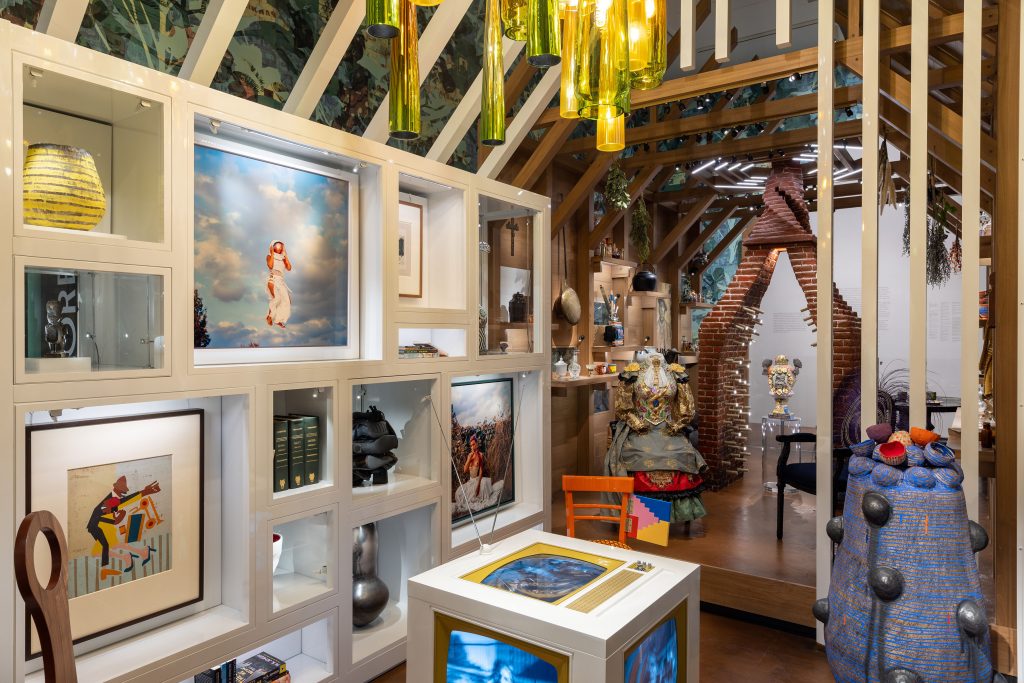
“Before Yesterday We Could Fly: An Afrofuturist Period Room.” Courtesy The Metropolitan Museum of Art/ Photo by Anna-Marie Kellen.
The room contains an incomplete shotgun house exterior with an adjoining kitchen and parlor orbiting a hearth, understood here as a center for technological innovation. The best position for viewing the art and ephemera inside is at the back of the house, where we become the fourth wall. Small cutouts invite us to peer in. To the right of the Medieval art hall, tucked between the European sculpture and decorative arts galleries, the space feels somewhat estranged from the rest of the museum.
Njideka Akunyili Crosby’s Thriving and Potential, Displaced (Again and Again and…) (2021) covers the exterior walls. Leaves from the okra plant and shadowy outlines of deciduous trees common to North America frame silhouetted portraits interspersed with design plans of Seneca Village lots and cut-up maps of the African continent. The photo-transferred images are printed on vinyl to create an atmosphere evocative of the overlapping temporalities and multiple geographies organizing the betwixt and between of living in the aftermath of slavery and colonialism.
As an Egun-born, Los-Angeles based artist, Crosby’s Afrocosmopolitanism syncs form and content indicative of the artist’s transatlantic acculturations: Here, there is a felt invocation of being at home in, and away from, multiple sites. The destruction, for example, of Seneca Village—wiped out by authorities under the guise of eminent domain—reverberates today in quickly gentrifying Harlem. Black lives and livelihoods remain precarious, while the terms of home and homecoming are continually under construction.
![Njideka Akunyili Crosby’s Thriving and Potential, Displaced (Again and Again and...) (2021) [detail]. Courtesy of the artist and the Metropolitan Museum of Art.](https://news.artnet.com/app/news-upload/2021/11/Njideka-Akunyili-Crosby_Thriving-and-Potential-Displaced-Again-and-Again-and...-DETAIL-635x1024.jpg)
Njideka Akunyili Crosby’s Thriving and Potential, Displaced (Again and Again and…) (2021) [detail]. Courtesy of the artist and the Metropolitan Museum of Art.
Born into slavery in the state of New York, the abolitionist Truth’s fight in the 19th century for the rights of all women is reflected in Catlett’s uptake of the linocut to show the historical necessity of radicalism in her own time. Today, it serves as an invitation to our own abolitionist citizenry.
In her book Afro-Atlantic Flight: Speculative Returns and the Black Fantastic, Commander argues for the development of a Pan-Africanist stance that more effectively addresses the contemporary resonances of slavery that exist across the diaspora. Answering this call of Pan-Africanist diasporic longing is a theme across the contemporary works on view.
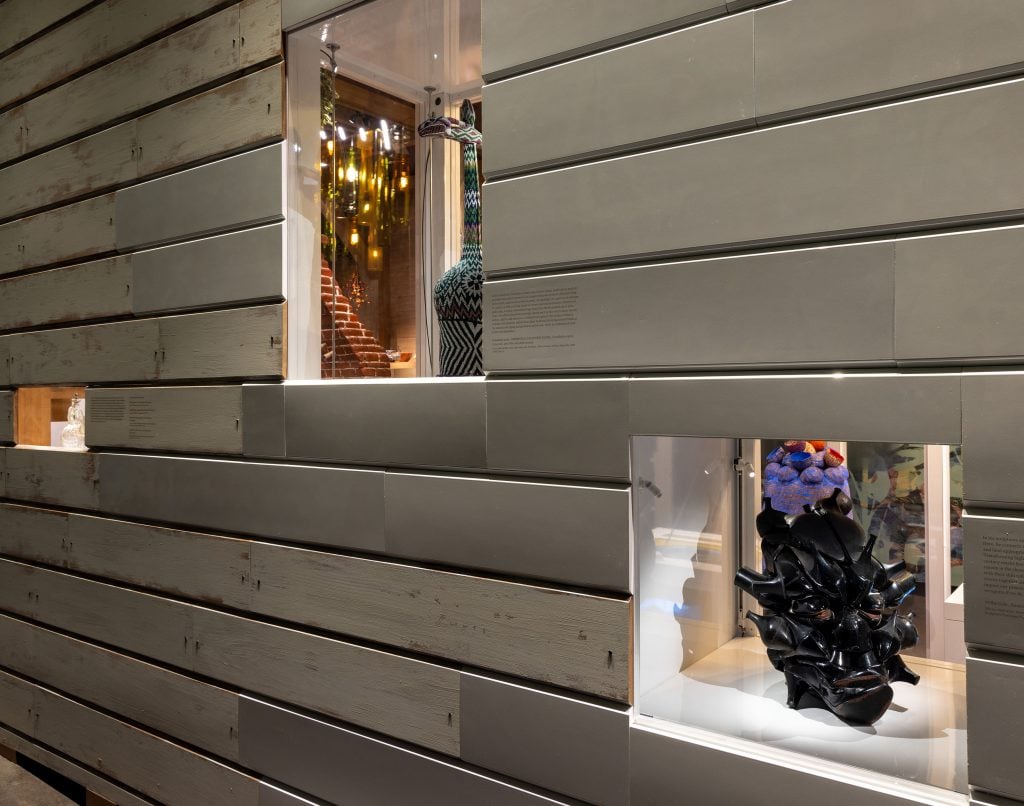
“Before Yesterday We Could Fly: An Afrofuturist Period Room.” Courtesy The Metropolitan Museum of Art/ Photo by Anna-Marie Kellen.
Willie Cole’s conceptual sculpture Shine (2007), constructed of patent-leather shoes, steel wire, monofilament line, washers, and screws, looks like a heavy ceremonial mask while also invoking the ritual of getting ready for church on Sunday morning. I reminisced with Commander over what is often a young Black girl’s first pair of “nice” shoes and the feeling of the “lace” accented frilly socks paired with them for Sunday school. Cole’s Shine holds both the recognition of the role of masks in important ceremonies imagined from the perspective of diasporic longing, as well as a material meditation on the colonization of the minds and bodies of Black people by European social constructions.
The legal end of slavery in New York State in 1827 was a hopeful time. Seneca Village was flourishing. Black people, some newly free others already living out of bondage, were able to purchase land (and thus access the vote). Yet not even 30 years later, Seneca Village was razed to make way for the construction of Central Park (a development that should loom over encounters with other parks plentiful in European metropoles).
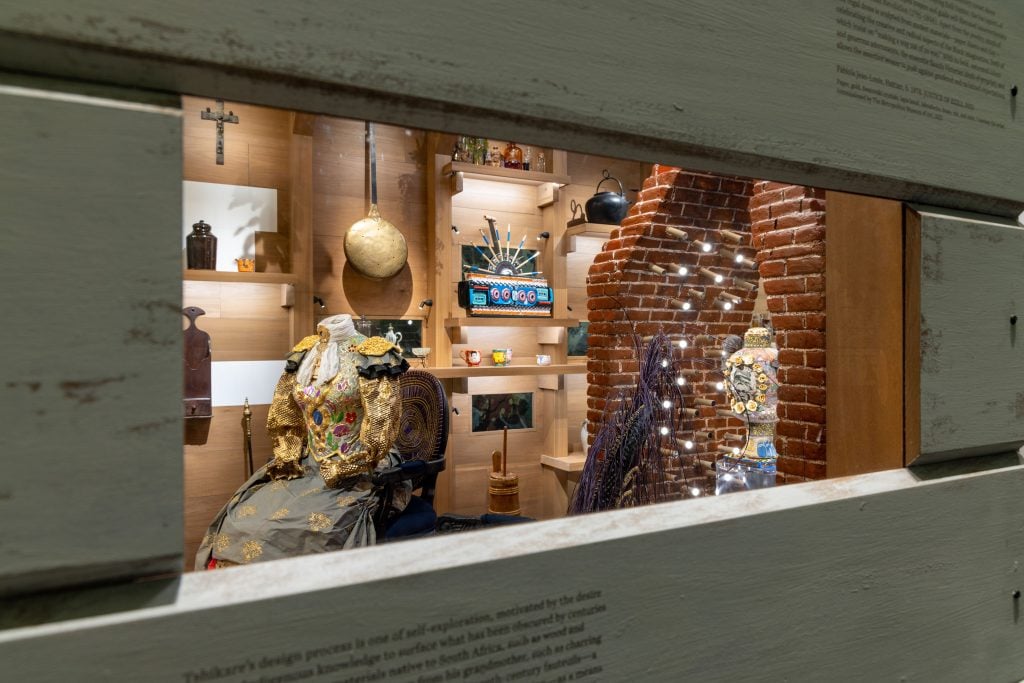
“Before Yesterday We Could Fly: An Afrofuturist Period Room.” Courtesy The Metropolitan Museum of Art/ Photo by Anna-Marie Kellen.
Viewers would do well to consider the differences between the fictional elitist fantasies conjured by the traditional period room and the critical fabulation—a term coined by Saidiya Hartman to denote the theorization happening through historical and archival research to fill in blanks left in the record—evident here. Ongoing research into communities like Seneca Village, rarely depicted as self-sustaining, require the devoted resources of cultural visionaries to foster a more comprehensive understanding of the past.
At the press preview, I asked Hannah Beachler how we should think about celebrating Black futures when skepticism (or even Afropessimism) seems to be the more appropriate attitude to have toward slow-moving institutions, from government to museums. She replied that we are living in a world of firsts, and as slow-moving as our institutions may be, it is our responsibility to be in the room to tell the truth.
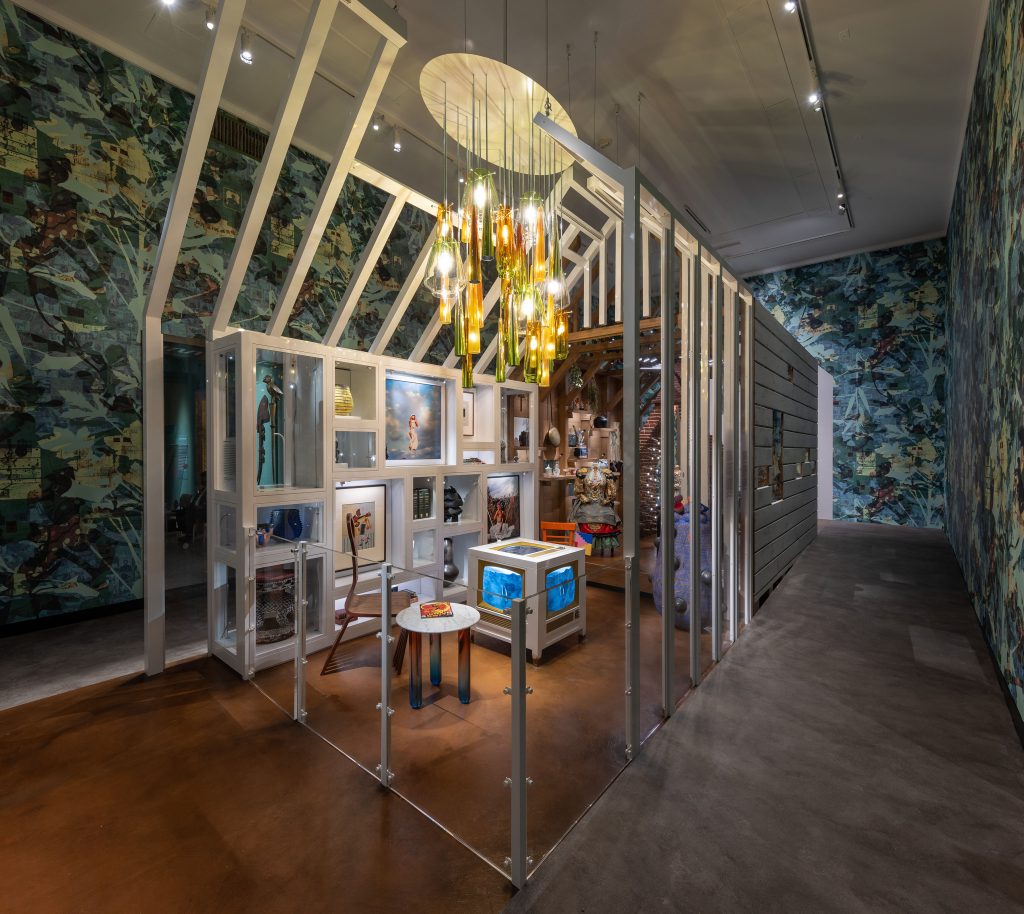



![Njideka Akunyili Crosby’s Thriving and Potential, Displaced (Again and Again and...) (2021) [detail]. Courtesy of the artist and the Metropolitan Museum of Art.](https://news.artnet.com/app/news-upload/2021/11/Njideka-Akunyili-Crosby_Thriving-and-Potential-Displaced-Again-and-Again-and...-DETAIL-635x1024.jpg)



